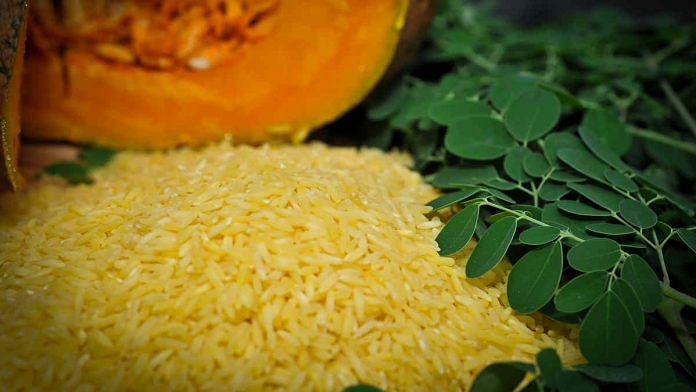New Delhi: Bangladesh may soon steal a march over India by beginning the cultivation of another genetically modified (GM) crop, golden rice, which is fortified with provitamin A and is expected to help check malnutrition.
This GM variant of the kitchen staple has been declared to be as safe for consumption as conventional varieties in a new study.
The variety, known as GR2E, is already approved for consumption in a number of countries, including Canada and the US.
Conducted by researchers from the Philippines-based International Rice Research Institute (IRRI), the fresh study was meant to satisfy regulatory requirements in the Philippines, Bangladesh and Indonesia.
The study was published in the journal Scientific Reports on 28 January.
The IRRI is engaged in reducing hunger and poverty through rice science, among other fields. According to the researchers, safety assessments on GR2E revealed that the rice was unlikely to cause allergies or toxicities. Rodents fed with the rice, they said, did not show any adverse reactions.
However, the study did not assess whether GR2E rice can effectively help combat vitamin A deficiency in affected populations.
Also Read: This is how GM crop Golden Rice could solve Vitamin-A deficiency in Asia
A tool to beat Vitamin A deficiency
GM crops are those that have been modified genetically to tackle certain problems or enhance their nutrition quotient. For example, Bt brinjal, a GM variety commercially cultivated in some countries, is equipped with pest-resistant properties.
However, they have been controversial in India, with some civil society groups raising health- and environment-related concerns. The only GM crop under commercial cultivation in India is Bt cotton.
India is yet to approve commercial cultivation of a genetically modified food crop. Bt brinjal was approved for cultivation in 2009, but has been under an indefinite moratorium pending further studies since 2010. In 2013, Bangladesh became the first South Asian country to allow the commercial cultivation of Bt brinjal, and a study released last year claimed it was helping local farmers earn and save more.
Golden rice is meant to tackle Vitamin A deficiency, a major public health problem, especially in South Asia.
Severe deficiency can lead to disorders such as childhood blindness, anaemia, and weakened immunity, increasing the risk of death from infectious diseases.
To combat this, researchers have long sought to develop varieties of rice that can act as a source of Vitamin A. The rice is expected to be especially crucial in tackling the deficiency in South and Southeast Asia, where rice is a staple food.
“Rice provides up to 70 per cent of the daily calorie requirements. If this rice also provided Vitamin A, malnutrition can be solved to a great extent — without any extra cost,” said Swapan Kumar Datta, pro-vice-chancellor of West Bengal’s Visva-Bharati University, who has done pioneering work in the field of genetic engineering.
“This could have been approved in India long back too, we have been involved in this project for many years. But somehow the government here does not have any interest in taking this forward,” he added. “Like Bt Brinjal did not work out in India… but it is growing in Bangladesh.”
Datta said there was enough scientific research to show that GM crops are safe for consumption.
The golden rice project first started in 1982 as an initiative of the Rockefeller Foundation, a New York-based philanthropy. In a scientific paper published in 2000, researchers from Germany and the US described successfully growing genetically modified rice varieties that had the ability to naturally produce beta-carotene or provitamin A. Provitamin is a substance that can be converted into vitamins once inside the body.
Beta-carotene is a pigment commonly found in colourful fruits and vegetables like carrots. In rice, the presence of this pigment gives it a characteristic golden colour.
In 2018, golden rice was approved for consumption in the US and Canada.
Also Read: Maharashtra farmers are asserting their freedom by celebrating HTBt cotton crop harvest







It is a deliberate article to promote GM crops and influence the policy makers. I wish the author and the every one to look in to the progress happened in Tamilnadu-Kerala state in fighting child malnutrition. Malnutrition is not due to non availability of nutrient rich foods but bcos of the less purchasing power.
the author cleverly blend the facts and myths to make the readers to believe in GM technology.
Indians do not even know what malnutrition does to IQ and they feed in mid day meals dry roti and one piece of onion. Only God can get rid of these morons from such jobs.